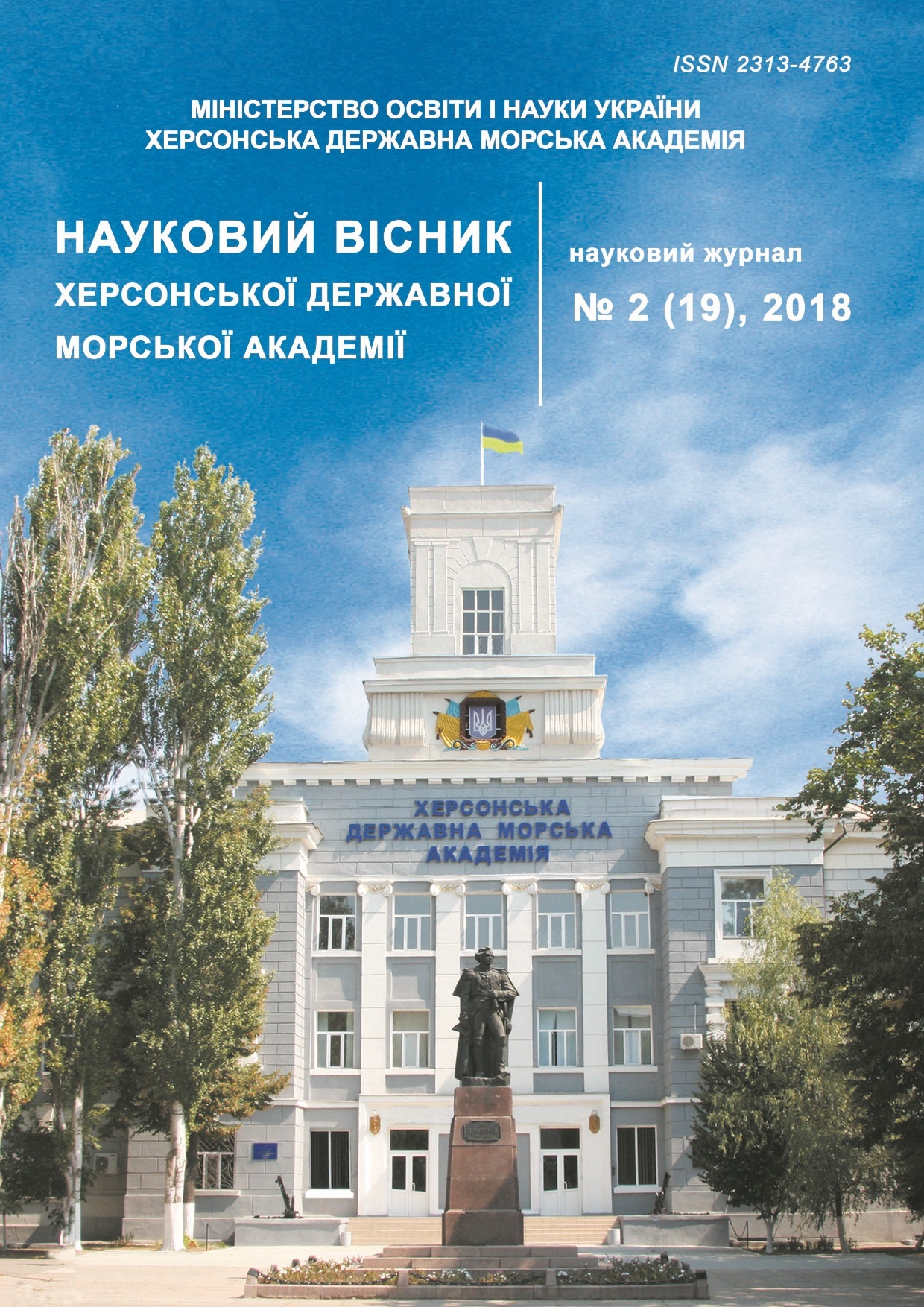THE USE OF MODIFIED EPOXY COMPOSITES WITH IMPROVED THERMOPHYSICAL PROPERTIES FOR RESTORATION OF SHIP HEAT EXCHANGERS WHILE OPERATING THE SHIP
10.33815/2313-4763.2018.2.19.131–139
Abstract
The paper presents prospects for the use of new materials on a polymer basis. Taking into account that the developed materials are used effectively enough to protect the equipment which is used at elevated temperatures, a study was carried out on the determination of the influence of nature and the content of the modifier on the thermophysical properties of the epoxy matrix. The epoxy oligomer of the mark ED-20 is chosen as the main component for the binder in the formation of epoxy composites. For crosslinking of epoxy compositions, a polyethylenepolyamine hardener is used, which allows to assert materials at room temperatures. The choice of 2,4-diaminoazobenzene-4'-carboxylic acid modifier for the improvement of the thermophysical properties of the developed polymeric composite materials is substantiated. In addition, it is shown that the critical content of an additive in a polymer is critical, since its excess amount leads to an increase in the sol-fraction in the materials. It is proved that the modifier contains functional groups that are active in the physical and chemical interaction with epoxy polymer. The latter interact with hydroxyl and epoxy groups of polymer resin, increasing the degree of crosslinking of epoxy composites. The thermal coefficient of linear expansion and heat resistance of epoxy composites is investigated. Thermal linear expansion coefficient (TCLR) of materials was calculated by the curve of the dependence of relative temperature deformation. The critical concentration of the modifier is established, the introduction of which provides a reduction of the thermal coefficient of linear expansion of the developed composites compared with the original epoxy matrix. At the same time shrinkage of composites decreases by an order of magnitude. The absolute values of the thermal coefficient of linear expansion of materials, which can be used in different temperature ranges, are established. It is interesting from a scientific and practical point of view that there is an analysis of the temperature range that covers the region of the glass-forming of polymer composites. It has been shown that in this range of temperatures the TCLR of modified materials is also significantly smaller than the original matrix. At the final stage of the study in the high temperature range, the difference between TCLR between the initial and modified matrices is no longer so significant. This suggests that the developed materials can be exploited in the temperature range ΔT = 303...473K, since under the influence of the thermal field not only the destruction of the physical bonds in the structural grid of the developed composites, but also the mobility of the segments and lateral groups of the macromolecules increases. In addition, it should be noted that the smallest indicators of TCLR among the entire range of studied temperature ranges are noted materials that contain a modifier for insignificant content. This allows to form a composite that allows to ensure the stability of the developed materials to linear and volumetric deformations in the process of exploitation. It has been established that for the formation of composite materials with elevated thermophysical properties, it is advisable to use a modifier in the quantity q = 0,5...1,0 mass. %. Such material is characterized by the greatest activation energy, resistance to structural transformations at maximum temperatures and intensive interaction of the functional groups of the filler and the epoxy oligomer during the formation at the molecular level among all investigated materials. On the basis of the tests of the thermophysical properties of epoxy composites filled with 2,4-diaminoazobenzene-4'-carboxylic acid modifier, the permissible limits of temperature were established for which it is possible to use the developed materials.
References
2. Kovalchuk M., Iurzhenko M., Demchenko V. & Senchenkov I. (2019). The investigation of the welding process of different-type polyethylenes. Advances in Thin Films, Nanostructured Materials and Coatings (Eds. Pogrebnjak A., Novosad V.). Singapore : Springer, 225–233.
3. Kolisnyk R., Korab M., Iurzhenko M., Masiuchok O., Shadrin A., Mamunya Ye., Pruvost S., & Demchenko V. (2019). Conductive polymer nanocomposites for novel heating elements. Advances in Thin Films, Nanostructured Materials and Coatings (Eds. Pogrebnjak A., Novosad V.). Singapore: Springer, 215–224.
4. Demchenko V., Iurzhenko M., Shadrin A., Galchun A. (2017). Relaxation behavior of polyethylene welded joints. Nanoscale Research Letters, 12. 280–285.
5. Brailo M. V., Buketov A. V., Kobelnyk O. S., Yakushchenko S. V., Sapronova A. V., Sapronov O. O. & Vasylenko A. O. (2018). Optymizatsiia vmistu dobavok u epoksy-poliefirnomu zviazuvachi dlia pidvyshchennia koheziinoi mitsnosti kompozytiv. Naukovyi visnyk NLTU Ukrainy : zbirn. nauk.-tekhn. prats. Lviv : NLTU. 28, 11, 71–77.
6. Buketov A. V., Dolhov N. A., Sapronov A. A. & Nyhalatyi V. D. (2018). Prochnost stseplenyia pry otrive y sdvyhe epoksydnikh nanokompozytnikh pokrityi, napolennnikh ultradyspersnim almazom. Problemy prochnosty, 3. 71–78.
7. Brailo M. V., Buketov A. V., Yakushchenko S. V., Yatsiuk V. M. (2018). Doslidzhennia teplofizychnykh vlastyvostei epoksy-poliefirnykh kompozytiv, modyfikovanykh metylendifenildiizotsianatom. Naukovi notatky. Lutsk : LNTU. 63, 27–33.
8. Buketov A. V., Kulinich A. H., Husev V. M., Smetankin S. O. & Yatsiuk V. M. (2018). Doslidzhennia adheziinykh vlastyvostei modyfikovanykh 4-aminobenzoinoiu kyslotoiu polimernykh kompozytnykh materialiv. Naukovi notatky. Lutsk : LNTU. 63, 34–39.
9. Buketov A. V., Amelin M. Yu., Bezbakh O. M. & Nehrutsa R. Yu. (2018). Zakhysni epoksykompozytni pokryttia z polipshenymy antykoroziinymy vlastyvostiamy i znosostiikistiu. Visnyk KhNTU, 2 (65), 11–18.
10. Buketov A. V., Kulinich A. H., Husiev V. M., Smetankin S. O. & Yatsiuk V. M. (2018). Vplyv modyfikatora 4-aminobenzoinoi kysloty na fizyko-mekhanichni vlastyvosti epoksydnykh kompozytnykh materialiv. Visnyk KhNTU, (65), 19–26.






